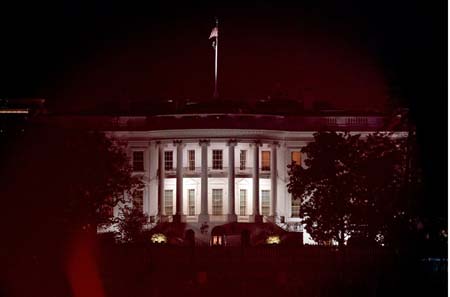“For half a century, ACA has been providing the world … with advocacy, analysis, and awareness on some of the most critical topics of international peace and security, including on how to achieve our common, shared goal of a world free of nuclear weapons.”
Nuclear Dangers and the 2024 Election
January/February 2024
By Daryl G. Kimball
As the new year begins, the existential risks posed by nuclear weapons continue to grow. A crucial factor in whether one or more of today’s nuclear challenges erupt into full-scale crisis, unravel the nonproliferation system, or worse will be the outcome of the U.S. presidential election.
 How the winner of the 2024 race will handle the evolving array of nuclear weapons-related challenges is difficult to forecast, but the records and policies of the leading contenders, President Joe Biden and former President Donald Trump, offer clues.
How the winner of the 2024 race will handle the evolving array of nuclear weapons-related challenges is difficult to forecast, but the records and policies of the leading contenders, President Joe Biden and former President Donald Trump, offer clues.
A major responsibility for any commander in chief is to avoid events that can lead to a nuclear war with Russia over its war on Ukraine and with China over its claims to Taiwan. One indicator of Trump’s more confrontational approach came in 2019 when, at a meeting of senior officials from the five nuclear-armed states recognized under the nuclear Nonproliferation Treaty (NPT), China proposed a joint statement reiterating that “a nuclear war cannot be won and must never be fought.” Two years later, Biden administration officials successfully pressed the group to reaffirm this Reagan-Gorbachev maxim, first enunciated in 1985.
Since then, Russian President Vladimir Putin’s full-scale attack on Ukraine and threats of nuclear use have raised the specter of nuclear conflict. To his credit, Biden has not issued nuclear counterthreats and has backed Ukraine in its struggle to repel Russia’s invasion. In 2022, Biden also joined leaders of the Group of 20 states in declaring that the use of nuclear weapons and threats of their use are “inadmissible.”
Well before Putin’s nuclear rhetoric turned ominous, Trump engaged in an alarming exchange of taunts with North Korean leader Kim Jong Un in 2017. His threats of unleashing “fire and fury” against Pyongyang fueled tensions on the Korean peninsula and provide another clue how he might behave in a crisis with China, North Korea, or Russia in a second term.
Effective U.S. leadership on arms control will be critical to avoid a destabilizing, three-way arms race after the New Strategic Arms Reduction Treaty expires in 2026. As the treaty’s first expiration deadline of February 5, 2021, was approaching, Trump refused to agree to simple extension of the pact, focusing instead on a failed effort to cajole China into joining Russian-U.S. arms talks. This left the incoming Biden administration only days to reach a deal with the Kremlin to extend the pact by five years, and it did.
In June 2023, the Biden administration proposed talks with Russia “without preconditions” on a new, post-2026 “nuclear arms control framework.” As long as there is war in Ukraine, the best outcome likely is a simple deal committing both sides to stay below the current limit of 1,550 deployed strategic warheads until a longer-term framework is concluded. Biden also has pursued nuclear risk reduction talks with China, which continues its nuclear buildup begun during the Trump era. In November, senior Chinese and U.S. officials held the first such talks in years.
Meanwhile, Iranian leaders continue increasing their capabilities to produce weapons-grade uranium in response to Trump's 2018 decision to withdraw unilaterally from the 2015 Joint Comprehensive Plan of Action and impose tougher U.S. sanctions to pressure Tehran into negotiating a new deal. They now are threatening to pull out of the NPT if the United States or other UN Security Council members snap back international sanctions against Iran.
Biden’s efforts to restore mutual compliance with the 2015 deal have been stymied by Iranian demands on matters outside the nuclear file and tensions over the war in Gaza. Avoiding a more severe crisis over Iran’s nuclear program will require more sophisticated U.S. diplomacy.
Kim has ramped up North Korean nuclear and missile development and stiff-armed overtures for talks with Washington ever since the disastrous 2019 Hanoi summit, when Trump flatly rejected Kim’s offer to dismantle the Yongbyon nuclear complex in return for limited sanctions relief, then walked out of the meeting. Renewed talks on curbing North Korea’s weapons program will require a recalibration of the U.S. approach.
Concerns about a possible nuclear testing revival also are rising. The Trump administration did not help when it declared in 2018 that the United States did not intend to ratify the Comprehensive Test Ban Treaty and in 2020 when senior Trump officials discussed resuming explosive testing to intimidate China and Russia. Biden, on the other hand, has reaffirmed U.S. support for the treaty; and his team proposed technical talks on confidence-building arrangements at the former Chinese, Russian, and U.S. test sites.
Most Americans do not vote based on candidates’ positions on nuclear weapons, but they are aware and deeply concerned about nuclear dangers. A 2023 national opinion survey found that large majorities believe that nuclear weapons are the most likely existential threat to the human race.
In 2024, the candidates’ approaches to these dangers deserve more scrutiny than usual. Presidential leadership may be the most important factor that determines whether the risk of nuclear arms racing, proliferation, and war will rise or fall in the years ahead.
